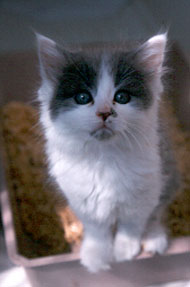- Home
- FAQs
- Customer Video Gallery
- Customer Photo Gallery
- Bird Facts
- Bird Food Blog
- Bird Information
- Feeding Advice
- Small Animal Information
- A to Z of Guinea Pigs
- A to Z of Hamsters
- A to Z of Rabbits
- Basic Care for Guinea Pigs
- Basic Care for Hamsters
- Basic Care for Rabbits
- Basic care for Chinchillas
- Basic care for Ferrets
- Basic care for Gerbils
- Basic care for Mice
- Basic care for Rats
- Buying a Healthy Small Animal
- Does your Reptile need a Licence
- Equipment for Ferrets
- Equipment for Hamsters
- Equipment for Mice
- Equipment for your Chinchilla
- Equipment for your Gerbil
- Equipment for your Guinea Pig
- Equipment for your Rabbit
- Keeping a House Rabbit
- Dog Information
- Cat Information
- Customer Information
- Fat Balls
- Suet Pellets
- Straights
- Seed Mixes
- Suet Treats
- Mealworms
- Bird Feeders
- My Account
Cats Toilet Training
Teach your kitten to use a litter tray by making the most of his natural instinct for cleanliness. It’s easy when you know how!
For many new kitten owners the subject of house-training never arises, since their newcomer often arrives already au fait with a litter tray. Indeed the cleanliness of the cat is one of the major reasons for its popularity: the fact that owners do not have to spend hours house-training their pet leads to favourable comparisons with puppies!
STARTING YOUNG
The process of litter training begins while the kittens are still with their mother, and they learn to toilet in appropriate locations by being exposed to litter materials from an early age. Queens (female cats) who have inappropriate indoor toileting habits tend to produce kittens with similar behaviour. It was once thought that kittens observing their mother using litter facilities was an important factor in their learning process, but this theory has been disproved. It is now believed that playing in litter is the first step towards successful litter training.
When kittens are born they are totally dependent on their mother and cannot go to the toilet unless she stimulates their bowel or bladder. She does this by licking her kittens’ abdomen and anogenital regions. As the babies become more mobile they begin to urinate and defecate independently. If mum uses a litter tray, her kittens are likely to follow her. By coming into contact with the soft, rakeable material in the tray, a raking response is triggered. Gradually an association is created between the feel of litter beneath the feet and the act of toileting.
MAXIMISING SUCCESS
It is helpful to offer your new kitten similar toilet facilities to those he's used to. This involves selecting a similar tray type and litter material, then placing them in a similar location. Of course the tray, litter and location also need to be suitable for the kitten’s requirements and they should reflect a feline’s natural choice as much as possible. When left to their own devices, cats select locations where there is a soft, rakeable surface such as topsoil or sand. In general terms, cat litter materials should reflect this choice and be fine and easily rakeable. Litter preference varies with each individual cat and a kitten’s personal choice will depend to some extent on the litter that he used in his previous home.
The preferred location for outdoor toileting is usually quiet and secluded and this should be reflected in the location of an indoor litter tray, so place it as far as possible from the hustle and bustle of family life. Cats prefer to keep eating and toileting separate so the tray needs to be placed far away from feeding bowls. A litter tray should be big enough for an adult cat to comfortably squat, toilet and turn around, as well as deep enough to contain enough litter to rake over and cover excretions. The decision whether to have a covered or open tray depends on which one your kitten prefers.
MAKING CHANGES
If you do not wish to use the same type of litter your kitten used in his previous home, change it gradually as he has probably developed a preference for what he’s used to. Do this by mixing new litter in with the old. When the time comes for him to be allowed outside, you may wish to change his preferred litter to soil or sand to encourage him to toilet in the garden.
Many cats make this transition easily, as the smell of faeces and urine from visiting neighbourhood cats leads to a latrine association with flower-beds! You can assist this process by mixing sand or topsoil in his litter tray for a few days before your kitten is allowed outside. A cat’s instinct not to soil his nest area is strong, so cats are likely to toilet in adjoining gardens rather than their own. This behaviour may lead to problems with neighbours – especially if they are not cat owners! It is difficult to encourage cats to toilet in your preferred location, but you can encourage site selection to some extent by tipping the contents of a soiled tray onto a patch of rakeable topsoil in your garden.
LITTER TRAY TRAINING
The best way to help instil appropriate associations with a litter tray is to place your kitten in the tray when it’s most likely he will need to relieve himself, ie after eating, playing and waking. Praise your kitten when he defecates or urinates, thereby encouraging an association between excretion and the tray.
If your kitten does not show a natural urge to rake litter, encourage him to do so by holding his paws gently and mimicking the raking action, as this is a trigger for toileting behaviour. Praise him as soon as he begins to relieve himself.
DEALING WITH MISTAKES
Accidents are likely to happen while kittens are young and it is important to ensure any mistakes are cleaned up effectively. To do this, use a product that will clean up fat and protein components of the deposit as well as remove the scent from a feline perspective. A 10% solution of biological washing powder is effective, providing the soiled area is rinsed with cold water afterwards and then sprayed with an alcohol (eg surgical spirit). Allow time for the alcohol smell to disperse before allowing the kitten access to the area again. It may help to supplement cleaning with the use of suitable deterrents in affected areas. These deterrents should mimic the feline methods of designating a safe territory, therefore food, toys and bedding can all be useful. This approach will prevent your kitten from forming inappropriate toileting associations with, for example, carpets and furniture, along with unsuitable locations in the house.
REAPING REWARD
Remember that punishment is never appropriate when house-training a kitten. Shouting at your cat or showing him his mistakes are counterproductive techniques that are likely to induce stress and make the training process slower. It is your responsibility to maximise your kitten’s chances of succeeding and this is achieved by providing appropriate facilities and rewarding appropriate behaviour. The more chances you give your kitten to get it right, the quicker he will learn!

For many new kitten owners the subject of house-training never arises, since their newcomer often arrives already au fait with a litter tray. Indeed the cleanliness of the cat is one of the major reasons for its popularity: the fact that owners do not have to spend hours house-training their pet leads to favourable comparisons with puppies!
STARTING YOUNG
The process of litter training begins while the kittens are still with their mother, and they learn to toilet in appropriate locations by being exposed to litter materials from an early age. Queens (female cats) who have inappropriate indoor toileting habits tend to produce kittens with similar behaviour. It was once thought that kittens observing their mother using litter facilities was an important factor in their learning process, but this theory has been disproved. It is now believed that playing in litter is the first step towards successful litter training.
When kittens are born they are totally dependent on their mother and cannot go to the toilet unless she stimulates their bowel or bladder. She does this by licking her kittens’ abdomen and anogenital regions. As the babies become more mobile they begin to urinate and defecate independently. If mum uses a litter tray, her kittens are likely to follow her. By coming into contact with the soft, rakeable material in the tray, a raking response is triggered. Gradually an association is created between the feel of litter beneath the feet and the act of toileting.
MAXIMISING SUCCESS
It is helpful to offer your new kitten similar toilet facilities to those he's used to. This involves selecting a similar tray type and litter material, then placing them in a similar location. Of course the tray, litter and location also need to be suitable for the kitten’s requirements and they should reflect a feline’s natural choice as much as possible. When left to their own devices, cats select locations where there is a soft, rakeable surface such as topsoil or sand. In general terms, cat litter materials should reflect this choice and be fine and easily rakeable. Litter preference varies with each individual cat and a kitten’s personal choice will depend to some extent on the litter that he used in his previous home.
The preferred location for outdoor toileting is usually quiet and secluded and this should be reflected in the location of an indoor litter tray, so place it as far as possible from the hustle and bustle of family life. Cats prefer to keep eating and toileting separate so the tray needs to be placed far away from feeding bowls. A litter tray should be big enough for an adult cat to comfortably squat, toilet and turn around, as well as deep enough to contain enough litter to rake over and cover excretions. The decision whether to have a covered or open tray depends on which one your kitten prefers.
MAKING CHANGES
If you do not wish to use the same type of litter your kitten used in his previous home, change it gradually as he has probably developed a preference for what he’s used to. Do this by mixing new litter in with the old. When the time comes for him to be allowed outside, you may wish to change his preferred litter to soil or sand to encourage him to toilet in the garden.
Many cats make this transition easily, as the smell of faeces and urine from visiting neighbourhood cats leads to a latrine association with flower-beds! You can assist this process by mixing sand or topsoil in his litter tray for a few days before your kitten is allowed outside. A cat’s instinct not to soil his nest area is strong, so cats are likely to toilet in adjoining gardens rather than their own. This behaviour may lead to problems with neighbours – especially if they are not cat owners! It is difficult to encourage cats to toilet in your preferred location, but you can encourage site selection to some extent by tipping the contents of a soiled tray onto a patch of rakeable topsoil in your garden.
LITTER TRAY TRAINING
The best way to help instil appropriate associations with a litter tray is to place your kitten in the tray when it’s most likely he will need to relieve himself, ie after eating, playing and waking. Praise your kitten when he defecates or urinates, thereby encouraging an association between excretion and the tray.
If your kitten does not show a natural urge to rake litter, encourage him to do so by holding his paws gently and mimicking the raking action, as this is a trigger for toileting behaviour. Praise him as soon as he begins to relieve himself.
DEALING WITH MISTAKES
Accidents are likely to happen while kittens are young and it is important to ensure any mistakes are cleaned up effectively. To do this, use a product that will clean up fat and protein components of the deposit as well as remove the scent from a feline perspective. A 10% solution of biological washing powder is effective, providing the soiled area is rinsed with cold water afterwards and then sprayed with an alcohol (eg surgical spirit). Allow time for the alcohol smell to disperse before allowing the kitten access to the area again. It may help to supplement cleaning with the use of suitable deterrents in affected areas. These deterrents should mimic the feline methods of designating a safe territory, therefore food, toys and bedding can all be useful. This approach will prevent your kitten from forming inappropriate toileting associations with, for example, carpets and furniture, along with unsuitable locations in the house.
REAPING REWARD
Remember that punishment is never appropriate when house-training a kitten. Shouting at your cat or showing him his mistakes are counterproductive techniques that are likely to induce stress and make the training process slower. It is your responsibility to maximise your kitten’s chances of succeeding and this is achieved by providing appropriate facilities and rewarding appropriate behaviour. The more chances you give your kitten to get it right, the quicker he will learn!











